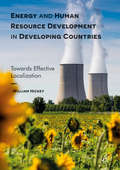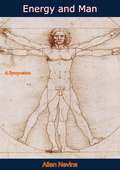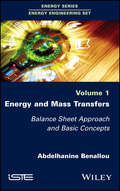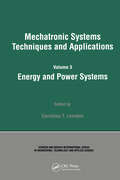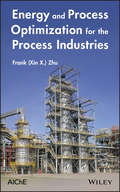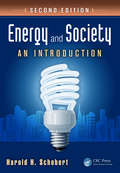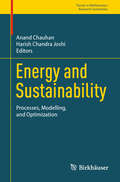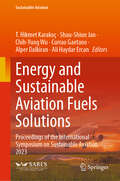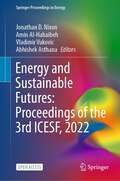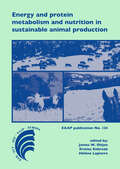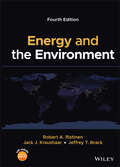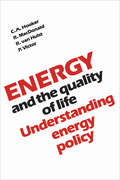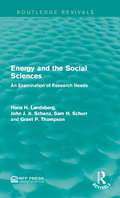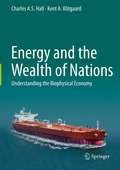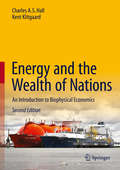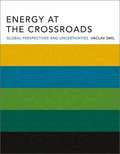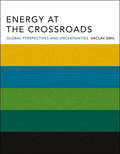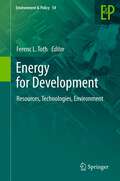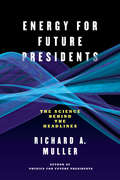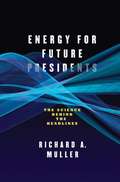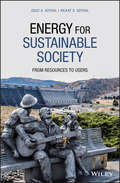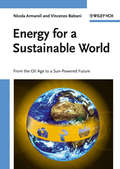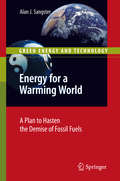- Table View
- List View
Energy and Human Resource Development in Developing Countries: Towards Effective Localization
by William HickeyThis book is about engaging and empowering people through their own domestic resources, by using upstream energy to create larger downstream employment opportunities. Incorporating sustainability, resource enhancement, and energy responsibility can generate awareness and better utilization of the resources and reduce reliance on foreign aid and economic development programs, which reinforce a North/ South consumption-based economy rather than empower the localized population. <P><P> The author proposes a new paradigm of employee development, localized engagement, and empowerment for resource-rich developing Asian countries, based on the utilization and upbraiding of their resources in-situ. Here scholars, policymakers, and investors will find that human resource development (HRD) can structure constructive change through criterion-based education and reap economic prosperity.
Energy and Man: A Symposium
by Allan Nevins Robert G. DunlopFirst published in 1960, Energy and Man is a book that comprises five speeches, together with follow-up questions, that were given by business school graduates at a symposium held at Columbia University on November 4, 1959.Contributions by Allan Nevins, Robert G. Dunlop, Edward Teller, Edward S. Mason and Herbert Hoover, Jr., with an Introduction by Courtney C. Brown.“THROUGH THE AGES, LEARNING HAS LOOKED TO THE WORLD of practical affairs for the major subjects of its interest. It is very appropriate that a great university, Columbia, through its Graduate School of Business, should share with a great industry, through its representative, the American Petroleum Institute, an inquiry into the role of energy, past, present, and future, in the lives of each of us.“So, when early in 1959 the American Petroleum Institute asked the Graduate School of Business if it would collaborate in the preparation and presentation of a comprehensive symposium...It was decided that it would be appropriate to consider energy in its several forms and to discuss circumstances that will best assure its continued availability in abundance. Thus, on November 4, 1959, a group of over three hundred government officials, economists, historians, scientists, and executives from a broad range of industry gathered in the rotunda of Columbia’s Low Memorial Library to hear delivered and to discuss the papers which are reprinted in this volume.”—Courtney C. Brown, Introduction
Energy and Mass Transfers: Balance Sheet Approach and Basic Concepts
by Abdelhanine BenallouThis is the first book of a series aiming at setting the basics for energy engineering. This book presents the fundamentals of heat and mass transfer with a step-by-step approach, based on material and energy balances. While the topic of heat and mass transfer is an old subject, the way the book introduces the concepts, linking them strongly to the real world and to the present concerns, is particular. The scope of the different developments keeps in mind a practical energy engineering view.
Energy and Matter (iScience)
by Alton L. BiggsIScience meets students where they are through engaging features and thought-provoking questions that encourage them to relate the science concepts to the world around them.
Energy and Power Systems
by Cornelius T. LeondesThe technical committee on mechatronics formed by the International Federation for the Theory of Machines and Mechanisms, in Prague, Czech Republic, adopted the following definition for the term: Mechatronics is the synergistic combination of precision mechanical engineering, electronic control and systems thinking in the design products and manufa
Energy and Process Optimization for the Process Industries
by Frank ZhuExploring methods and techniques to optimize processing energy efficiency in process plants, Energy and Process Optimization for the Process Industries provides a holistic approach that considers optimizing process conditions, changing process flowschemes, modifying equipment internals, and upgrading process technology that has already been used in a process plant with success. Field tested by numerous operating plants, the book describes technical solutions to reduce energy consumption leading to significant returns on capital and includes an 8-point Guidelines for Success. The book provides managers, chemical and mechanical engineers, and plant operators with methods and tools for continuous energy and process improvements.
Energy and Society: An Introduction, Second Edition
by Harold H. SchobertEnergy and Society: An Introduction, Second Edition provides readers with a detailed introduction to energy sources and energy utilization. This book presents an overview of alternative energy issues and technologies, discusses the pros and cons of various energy sources, and explores their impacts on society and the environment.What's New in the S
Energy and Sustainability: Processes, Modelling and Optimization (Trends in Mathematics)
by Anand Chauhan Harish Chandra JoshiThis volume addresses SDG 7 (Affordable and Clean Energy) and SDG 12 (Sustainable Consumption and Production). By 2030, therefore, people have to substantially increase their share of renewable energy. The book focuses on waste as primary sources of biomass that can fulfill energy requirements for sustainable development. It also discusses various related topics such as energy production methods, a mathematical model for the development of a sustainable biofuels supply chain, economic analysis, optimization techniques, multiple-criteria decision-making and mixed-integer linear programming and existing and emerging policies that encourage the switch to renewable energy. It is committed to fusing science and technology in a way that assures a sustainable future and addresses major topics on biofuels: biomass, bioenergy, biodiesel, bioethanol, biogas modelling and their supply chain management, inventory control and optimization.The 2030 Agenda for Sustainable Development, adopted by all United Nations Member countries in 2015, provides a shared blueprint for peace and prosperity for people and the planet, now and into the future. The book uses an interdisciplinary approach and provides solutions to energy requirements by using emerging technology and nanotechnologies. It explores a technical breakdown of the tools that may be utilized to convert biomass into usable energy forms. At the end of the book, a description of the social and economic aspects of renewable energy and minimization of bioenergy cost is presented. The book is useful to students, researchers, industry experts and anybody in the adoption of renewable energy. It covers the complete course in the fundamentals of biomass feedstock and their supply chain management resources at the graduate level in engineering.
Energy and Sustainable Aviation Fuels Solutions: Proceedings of the International Symposium on Sustainable Aviation 2023 (Sustainable Aviation)
by Alper Dalkiran Ali Haydar Ercan T. Hikmet Karakoç Shau-Shiun Jan Chih-Yung Wu Currao GaetanoSustainable aviation is a long-term strategy to provide innovative solutions to the aviation industry's challenges. The International Symposium on Sustainable Aviation is a multi-disciplinary symposium that presents research on sustainability-based issues and future trends in aviation from an economic, social, and environmental perspective. The conference provides a platform offering insights on a broad range of current topics in aviation, such as improving aircraft fuel efficiency, fostering the use of biofuels, minimizing environmental impact, mitigating GHG emissions, and reducing engine and airframe noise. ISEAS allows researchers, scientists, engineers, practitioners, policymakers, and students to exchange information, present new technologies, and developments. Also, discuss future direction, strategies, and priorities in aviation and sustainability.
Energy and Sustainable Futures: Proceedings of the 3rd ICESF, 2022 (Springer Proceedings in Energy)
by Amin Al-Habaibeh Abhishek Asthana Vladimir Vukovic Jonathan D. NixonThis is an open access book. This book contains research papers presented at the 3rd International Conference on Energy and Sustainable Futures (ICESF), which took place at Coventry University, UK, in 2022. The ICESF is an annual conference organised by the UK-based Doctorial Training Alliance (DTA) programme. It is a multidisciplinary conference focused on addressing the future challenges and opportunities for meeting global energy targets and sustainable development goals. The conference brought together academic researchers, industry experts and research students to showcase the latest innovations and research on a wide range of topics in the areas of energy and sustainability, including • renewable energy; • ICT and control; • computational fluid dynamics; • optimization; • conventional energy sources; • energy governance; • materials in energy research; • energy storage and • energy access.
Energy and protein metabolism and nutrition in sustainable animal production
by Ermias Kebreab James W. Oltjen Hélène LapierreAs world population increases, demand for food and particularly animal products is expected to grow substantially. Because of limited area for expansion of animal agriculture and growing consumer concern for the environmental impact of animal production, gains in animal efficiency will have to be part of the solution. This book addresses key issues of how energy and protein are utilized and interact in farm animals from the molecular to the whole animal and even to the herd or group level of organization. It contains state-of-the-art research and reviews on several topics of nutrient utilization and metabolism from top scientists worldwide. Key issues addressed include energy/protein interactions, methodology such as in vitro and in vivo techniques, regulation including pre-natal programming and endocrine regulation, modeling and systems biology (including a tribute to the late Professor R. Lee Baldwin of the University of California, Davis, a leader in the field), products and health of animals, tissue metabolism, and environmental sustainability in agriculture. This book is a valuable resource for researchers, students, policy makers, producers and industry professionals believing that a better understanding of metabolism and nutrition of farm animals is part of the solution.
Energy and the Environment
by Robert A. Ristinen Jack J. Kraushaar Jeffrey T. BrackEnergy and the Environment Examine the tension between energy production and consumption and environmental conservation with the latest edition of this widely read text In the newly revised Fourth Edition of Energy and the Environment, the authors deliver an insightful and expanded discussion on the central topics regarding the interaction between energy production, consumption, and environmental stewardship. The book explores every major form of energy technology, including fossil fuels, renewables, and nuclear power, wrapping up with chapters on how energy usage affects our atmosphere, and the resulting global effects. The latest edition includes new figures and tables that reflect the most recent numbers on conventional and renewable energy production and consumption. The history and current status of relevant U.S. and international governmental energy legislation is discussed along with the text. Readers will also find: A thorough introduction to the fundamentals of energy and energy use in industrial societies, including the forms of energy, scientific notation, and the principle of energy conservation A comprehensive exploration of fossil fuels, including petroleum, coal, and natural gas, along with their history, world production, and remaining future resources Discussion of the pros and cons of nuclear power, it’s rise in China, and it’s fall elsewhere, and a history of power plant accidents A practical discussion of heat engines, including their thermodynamics, energy content of fuels, and heat pumps and engines In-depth examinations of new innovations and rapidly increasing use of renewable energy sources, including solar, wind, hydro, geothermal, and biomass energy, along with updates on battery technology and alternative energy storage techniques Detailed discussions of the atmospheric effects of our energy usage on scales both local and global; reports from the International Panel on Climate Change; the carbon budget, carbon capture and storage, and geoengineering Perfect for either graduate or upper-level undergraduate students of physics, environmental science, and engineering, Energy and the Environment is also an indispensable resource for anyone professionally or personally interested in climate change, energy policy, and energy conservation.
Energy and the Environment: Sources, Technologies, and Impacts
by Reza ToossiEnergy and the Environment is conceived and written at a level suitable for use as an introductory undergraduate textbook in energy and environment for students with very little mathematics or science background. It can also be used by anyone interested in technical, political, environmental, and economical issues related to energy. To make the text appropriate for engineering and science students, additional topics are included within information boxes placed throughout the book, and in the appendices. Examples requiring algebra are indicated in a similar manner. Depending on the audience, instructors can decide to eliminate all or part of this material without loss of continuity. Each chapter in Energy and the Environment stands alone, and the text can be taught in any order that the instructor deems suitable. Widely different curricula can therefore be designed and tailored for any audience simply by focusing on the appropriate sections from the appropriate chapters. For example, an environmental engineering course might include the summaries of various energy sources types, with an emphasis on air pollution, radiation, and environmental economics. A science curriculum might alternately emphasize the various technological sections and incorporate some of the engineering designs. This book is now available and can be purchased at http://vervepublishers.com. You may also order a free examination copy if you are considering adopting the Energy and the Environment for your classes. I would be most pleased to receive comments and thank you for your time!
Energy and the Quality of Life: Understanding Energy Policy
by Clifford Hooker Robert Macdonald Robert Van Hulst Peter VictorAs the supply/cost crunch tightens, issues related to energy become increasingly compelling. This is a guide for the general public to the fossil fuel crisis facing Canada, and Ontario in particular. It is also about other long-term matters of greater importance: the economic, socio-political, and cultural consequences of the choices which now have to be made, primarily by governments. The authors argue that energy policy is social policy. Therefore our ideas about the kind of society we want must be a governing consideration in working out a policy to take Canada through the energy crisis. The four writers bring to bear on the problem the perspectives of engineering, philosophy, environmental studies, and economics. The result is a balanced guide for the continuing debate on the adaptation of society to the imperatives of energy.
Energy and the Social Sciences: An Examination of Research Needs (Routledge Revivals)
by Sam H. Schurr Hans H. Landsberg John J. Schanz, Jr. Grant P. ThompsonOriginally published in 1974, this report dwells on the problems of meeting global energy demands and the time, effort and knowledge needed to research new energy methods. With rising costs, the uncertainty of supply from the Middle East and concern over the environmental impact of energy products, Energy and the Social Sciences outlines the intense need for well-designed research. This title will be of interest to students of Environmental Studies.
Energy and the Wealth of Nations
by Charles A. Hall Kent A. KlitgaardFor the past 150 years, economics has been treated as a social science in which economies are modeled as a circular flow of income between producers and consumers. In this "perpetual motion" of interactions between firms that produce and households that consume, little or no accounting is given of the flow of energy and materials from the environment and back again. In the standard economic model, energy and matter are completely recycled in these transactions, and economic activity is seemingly exempt from the Second Law of Thermodynamics. As we enter the second half of the age of oil, and as energy supplies and the environmental impacts of energy production and consumption become major issues on the world stage, this exemption appears illusory at best. In Energy and the Wealth of Nations, concepts such as energy return on investment (EROI) provide powerful insights into the real balance sheets that drive our "petroleum economy." Hall and Klitgaard explore the relation between energy and the wealth explosion of the 20th century, the failure of markets to recognize or efficiently allocate diminishing resources, the economic consequences of peak oil, the EROI for finding and exploiting new oil fields, and whether alternative energy technologies such as wind and solar power meet the minimum EROI requirements needed to run our society as we know it. This book is an essential read for all scientists and economists who have recognized the urgent need for a more scientific, unified approach to economics in an energy-constrained world, and serves as an ideal teaching text for the growing number of courses, such as the authors' own, on the role of energy in society.
Energy and the Wealth of Nations: Understanding The Biophysical Economy
by Charles A.S. Hall Kent KlitgaardIn this updated edition of a groundbreaking text, concepts such as energy return on investment (EROI) provide powerful insights into the real balance sheets that drive our “petroleum economy.” Hall and Klitgaard explore the relation between energy and the wealth explosion of the 20th century, and the interaction of internal limits to growth found in the investment process and rising inequality with the biophysical limits posed by finite energy resources. The authors focus attention on the failure of markets to recognize or efficiently allocate diminishing resources, the economic consequences of peak oil, the high cost and relatively low EROI of finding and exploiting new oil fields, including the much ballyhooed shale plays and oil sands, and whether alternative energy technologies such as wind and solar power can meet the minimum EROI requirements needed to run society as we know it.For the past 150 years, economics has been treated as a social science in which economies are modeled as a circular flow of income between producers and consumers. In this “perpetual motion” of interactions between firms that produce and households that consume, little or no accounting is given of the flow of energy and materials from the environment and back again. In the standard economic model, energy and matter are completely recycled in these transactions, and economic activity is seemingly exempt from the Second Law of Thermodynamics. As we enter the second half of the age of oil, when energy supplies and the environmental impacts of energy production and consumption are likely to constrain economic growth, this exemption should be considered illusory at best. This book is an essential read for all scientists and economists who have recognized the urgent need for a more scientific, empirical, and unified approach to economics in an energy-constrained world, and serves as an ideal teaching text for the growing number of courses, such as the authors’ own, on the role of energy in society.
Energy at the Crossroads
by Vaclav SmilIn Energy at the Crossroads, Vaclav Smil considers the twenty-first century's crucial question: how to reconcile the modern world's unceasing demand for energy with the absolute necessity to preserve the integrity of the biosphere. With this book he offers a comprehensive, accessible guide to today's complex energy issues -- how to think clearly and logically about what is possible and what is desirable in our energy future. After a century of unprecedented production growth, technical innovation, and expanded consumption, the world faces a number of critical energy challenges arising from unequal resource distribution, changing demand patterns, and environmental limitations. The fundamental message of Energy at the Crossroads is that our dependence on fossil fuels must be reduced not because of any imminent resource shortages but because the widespread burning of oil, coal, and natural gas damages the biosphere and presents increasing economic and security problems as the world relies on more expensive supplies and Middle Eastern crude oil. Smil begins with an overview of the twentieth century's long-term trends and achievements in energy production. He then discusses energy prices, the real cost of energy, and "energy linkages" -- the effect energy issues have on the economy, on quality of life, on the environment, and in wartime. He discusses the pitfalls of forecasting, giving many examples of failed predictions and showing that unexpected events can disprove complex models. And he examines the pros and cons not only of fossil fuels but also of alternative fuels such as hydroenergy, biomass energy, wind power, and solar power. Finally, he considers the future, focusing on what really matters, what works, what is realistic, and which outcomes are most desirable.
Energy at the Crossroads: Global Perspectives and Uncertainties (The\mit Press Ser.)
by Vaclav SmilAn objective, comprehensive, and accessible examination of today's most crucial problem: preserving the environment in the face of society's insatiable demand for energy.In Energy at the Crossroads, Vaclav Smil considers the twenty-first century's crucial question: how to reconcile the modern world's unceasing demand for energy with the absolute necessity to preserve the integrity of the biosphere. With this book he offers a comprehensive, accessible guide to today's complex energy issues—how to think clearly and logically about what is possible and what is desirable in our energy future.After a century of unprecedented production growth, technical innovation, and expanded consumption, the world faces a number of critical energy challenges arising from unequal resource distribution, changing demand patterns, and environmental limitations. The fundamental message of Energy at the Crossroads is that our dependence on fossil fuels must be reduced not because of any imminent resource shortages but because the widespread burning of oil, coal, and natural gas damages the biosphere and presents increasing economic and security problems as the world relies on more expensive supplies and Middle Eastern crude oil.Smil begins with an overview of the twentieth century's long-term trends and achievements in energy production. He then discusses energy prices, the real cost of energy, and "energy linkages"—the effect energy issues have on the economy, on quality of life, on the environment, and in wartime. He discusses the pitfalls of forecasting, giving many examples of failed predictions and showing that unexpected events can disprove complex models. And he examines the pros and cons not only of fossil fuels but also of alternative fuels such as hydroenergy, biomass energy, wind power, and solar power. Finally, he considers the future, focusing on what really matters, what works, what is realistic, and which outcomes are most desirable.
Energy for Development: Resources, Technologies, Environment
by Ferenc L. TothThis collection of contributions from a diverse group of prominent international scientists and policy makers brings together their in-depth analyses and innovative ideas about how to resolve the 'energy for development' predicament. It includes studies quantifying the role of energy in socioeconomic development, analysis of the interplay between supranational and national institutions in policy implementation, the energy implications of demographic trends such as urbanisation, and exploration of supply-side issues such as the potential role of nuclear energy and 'cleaning' fossil fuel energy generation through carbon capture.
Energy for Future Presidents: The Science Behind The Headlines
by Richard A. MullerThe author of Physics for Future Presidents returns to educate all of us on the most crucial conundrum facing the nation: energy. The near-meltdown of Fukushima, the upheavals in the Middle East, the BP oil rig explosion, and the looming reality of global warming have reminded the president and all U.S. citizens that nothing has more impact on our lives than the supply of and demand for energy. Its procurement dominates our economy and foreign policy more than any other factor. But the "energy question" is more confusing, contentious, and complicated than ever before. We need to know if nuclear power will ever really be safe. We need to know if solar and wind power will ever really be viable. And we desperately need to know if the natural gas deposits in Pennsylvania are a windfall of historic proportions or a false hope that will create more problems than solutions. Richard A. Muller provides all the answers in this must-read guide to our energy priorities now and in the coming years.
Energy for Future Presidents: The Science behind the Headlines
by Richard A. MullerThe near-meltdown of Fukushima, the upheavals in the Middle East, the BP oil rig explosion, and the looming reality of global warming have reminded the president and all U. S. citizens that nothing has more impact on our lives than the supply of and demand for energy. Its procurement dominates our economy and foreign policy more than any other factor. But the energy question is more confusing, contentious, and complicated than ever before. We need to know if nuclear power will ever really be safe. We need to know if solar and wind power will ever really be viable. And we desperately need to know if the natural gas deposits in Pennsylvania are a windfall of historic proportions or a false hope that will create more problems than solutions. Richard A. Muller provides all the answers in this must-read guide to our energy priorities now and in the coming years.
Energy for Sustainable Society: From Resources to Users
by Oguz A. Soysal Hilkat S. SoysalA handbook of sustainable energy, covering entire energy aspects from present status to future alternatives under one umbrella This book takes an interdisciplinary system approach to evaluating energy systems so that readers can gain the necessary technical foundation to perform their own performance evaluations and understand their interactions with socioeconomic indicators. Topics include the current and future availability of primary sources, energy supply chain, conversion between different forms of energy, security of energy supply, and efficient end-use of energy sources. Each chapter provides readers with comprehensive background information, an outline of the current technologies, and potential future developments. The book also examines the global, economic, societal, ethical, and environmental issues associated with currently used energy technologies. Energy for Sustainable Society: From Resources to Users starts with ageneral overview of energy systems, and describes the major elements of energy transformation and supply chain. It then discusses interdisciplinary career opportunities in the “energy engineering” field. The fundamental concepts of energy conversion, transmission, and load flow in electrical systems are covered, as are conventional and unconventional fossil fuels, and the basics of nuclear power generation and reactor types. Other chapters look at: the fundamental concepts of thermodynamics and basic operation of steam turbines, gas turbines, and combined cycle heat engines used in fossil fuel and nuclear power plants; current technologies in hydroelectric power generation; renewable and alternative energy sources; energy security issues; and more. Contains up-to-date information on renewable energy technologies such as grid-tie, net-zero energy, battery backup, and utility-independent micro grids Presents the status of the share of renewable sources in the current and future energy supply mix Provides solved examples, case studies, self-assessment quizzes, and problems to enhance the understanding of readers Includes an exclusive chapter on energy security issues Supplemented with a companion web site featuring a solutions manual, sample problems, and additional reading material Energy for Sustainable Society gives readers a solid foundation to study energy related subjects and is an ideal book for a first course on energy systems for upper division undergraduate and first year graduate students.
Energy for a Sustainable World: From the Oil Age to a Sun-Powered Future
by Vincenzo Balzani Nicola ArmaroliAn easy read, balancing the pros and cons, this book surveys the energy issue from a broad scientific perspective while considering environmental, economic, and social factors. It explains the basic concepts, provides a historical overview of energy resources, assesses our unsustainable energy system based on fossil fuels, and shows that the energy crisis is not only a tough challenge, but also an unprecedented opportunity to become more concerned about the world in which we live and the society we have built up. By outlining the alternatives for today and the future, it gives an extensive overview on nuclear energy, solar thermal and photovoltaics, solar fuels, wind power, ocean energies and other renewables, highlighting the increasing importance of electricity and the long-term perspectives of a hydrogen-based economy. An excellent source of updated and carefully documented information on the entangled aspects of the energy issue, this book is a guide for scientists, students and teachers looking for ways out of the energy and climate crisis, and the problems and disparities generated during the fossil fuel era.
Energy for a Warming World
by Alan John Sangster"Energy for a Warming World" challenges the commonplace notion that the amount of power which mankind can potentially harness from renewable resources is more than large enough to assuage future demand levels. By examining the renewable issue from an electrical engineering perspective, and exercising due regard for the limited capability of current and future electrical generation and transmission systems, this book attempts to provide more realistic statistics for the levels of power which could be extracted from sustainable resources in the critical time frame of 30 to 40 years. The engineering logic leads inexorably to the importance of taking a global outlook on the switch to renewable power supply and transmission - an outlook which has some surprising and uncomfortable ramifications for mankind. "Energy for a Warming World" provides a new perspective on renewable resources for academics and researchers in environmental or electrical power engineering, as well as to students in related areas.
